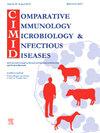Prevalence and risk factors of Chlamydia abortus infection in small ruminants from North-Central Algeria
IF 2
3区 农林科学
Q4 IMMUNOLOGY
Comparative Immunology Microbiology and Infectious Diseases
Pub Date : 2025-10-06
DOI:10.1016/j.cimid.2025.102408
引用次数: 0
Abstract
Chlamydia abortus is a zoonotic pathogen responsible for enzootic abortion in sheep and goats, posing a significant threat to both livestock productivity and public health. In order to assess the prevalence of Chlamydia abortus and associated risk factors in the small ruminant population, a cross-sectional study was conducted between January 2023 and December 2024 across four provinces in north-central Algeria (Medea, Blida, Aïn Defla, and Djelfa). A total of 896 sheep and goats from 96 herds were tested using an indirect ELISA targeting anti-C. abortus IgG antibodies. The prevalence at the herd level and the individual level was 84.4 % and 30.4 %, respectively. Mixed-species herds showed the highest herd-level prevalence (87.8 %), followed by sheep (82.8 %) and goat herds (77.8 %). Transhumant herds (91.4 %) and those with reproductive losses (90.5 %) exhibited elevated prevalence rates, although the differences were not statistically significant. In contrast, large herds (>100 head) had significantly higher infection rates (95.2 %). At the individual level, females had a higher, though non-significant, prevalence than males (31.8 % vs. 25.3 %). Animals older than four years and females with reproductive disorders exhibited the highest seroprevalence rates (38.2 % and 60.0 %, respectively), both associations being statistically significant. The province of Djelfa emerged as the most affected province, with the highest herd-level (91.4 %) and individual-level (36.5 %) prevalence. These findings confirm the endemicity of Chlamydia abortus in north-central Algeria and call for improved surveillance and prevention.
阿尔及利亚中北部小反刍动物流产衣原体感染流行及危险因素分析。
流产衣原体是引起绵羊和山羊地方性流产的人畜共患病原体,对牲畜生产力和公共卫生构成重大威胁。为了评估小反刍动物种群中流产衣原体的流行情况及其相关危险因素,于2023年1月至2024年12月在阿尔及利亚中北部4个省(Medea、Blida、Aïn Defla和Djelfa)进行了一项横断面研究。采用间接ELISA法对96个畜群的896只绵羊和山羊进行了抗- c抗体检测。流产IgG抗体。种群水平和个体水平的患病率分别为84.4 %和30.4 %。混合种牧群发病率最高(87.8 %),其次是绵羊(82.8 %)和山羊(77.8 %)。失育兽群(91.4 %)和失育兽群(90.5 %)患病率升高,但差异无统计学意义。相比之下,大群(bbb100头)感染率显著高于大群(95.2% %)。在个体水平上,女性的患病率高于男性(31.8% % vs. 25.3% %)。4岁以上的动物和有生殖障碍的雌性动物的血清患病率最高(分别为38.2 %和60.0 %),两者的相关性具有统计学意义。杰尔法省是受影响最严重的省份,其群体水平(91.4% %)和个人水平(36.5% %)的患病率最高。这些发现证实了流产衣原体在阿尔及利亚中北部的流行,并呼吁加强监测和预防。
本文章由计算机程序翻译,如有差异,请以英文原文为准。
求助全文
约1分钟内获得全文
求助全文
来源期刊
CiteScore
4.60
自引率
0.00%
发文量
102
审稿时长
40 days
期刊介绍:
Comparative Immunology, Microbiology & Infectious Diseases aims to respond to the concept of "One Medicine" and to provide a venue for scientific exchange. Based on the concept of "Comparative Medicine" interdisciplinary cooperation between specialists in human and animal medicine is of mutual interest and benefit. Therefore, there is need to combine the respective interest of physicians, veterinarians and other health professionals for comparative studies relevant to either human or animal medicine .
The journal is open to subjects of common interest related to the immunology, immunopathology, microbiology, parasitology and epidemiology of human and animal infectious diseases, especially zoonotic infections, and animal models of human infectious diseases. The role of environmental factors in disease emergence is emphasized. CIMID is mainly focusing on applied veterinary and human medicine rather than on fundamental experimental research.

 求助内容:
求助内容: 应助结果提醒方式:
应助结果提醒方式:


